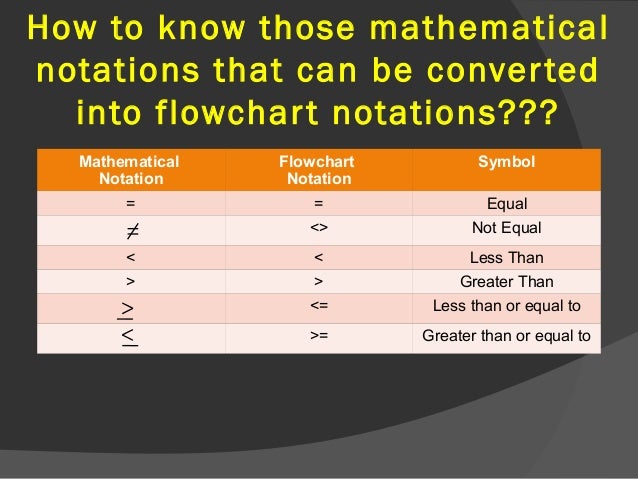

- #Programming symbol for does not equal full
- #Programming symbol for does not equal software
- #Programming symbol for does not equal free
Let us demonstrate this with the below example. Now let us see an example where not equal to the operator can be defined as “is not” when using conditional loops like if … else. Therefore the not equal to operator prints, the operands have different values though the value is given is 5 to both operands where one is int, and the other is string type.

In the above program, we can see we have declared two variable, x as an int data type with value 5 and y as a string data type with value “5”. Print("Program to demonstrate not equal to operator with different data types of operands:") Let us demonstrate below with an example. In Python, when we are using not equal to operator, then we have to note that the two operands that are declared must be of the same data type else in Python, if both the operands have different data types, then it will return not equal. To see the above program to have the output as “False”, then we need to define the values of two operands x and y with the same value. We can see we are trying to print the result of the expression x != y, which will print “True” as both the given operands are not equal. In the above program, we can see we have declared two variables, x and y, which are considered as operands with values 5 and 3. Print("The manipulation after applying not equal to operator on above operands is as follows:") Print("The second operand with its value is as follows:") Print("The first operand with its value is as follows:") Print("Program to demonstrate not equal to (!=) operator is as follows:") Now let us see an example to demonstrate the not equal to the operator (!=). In the above syntax, we saw that we can define “not equal to” in two ways in Python using “!=” or “is not” in the expressions or conditions and returns the Boolean value “True” or “False” having operands with the same type on both sides of the operator. This statement or expression will return Boolean values such as “True” or “False”.
#Programming symbol for does not equal software
Web development, programming languages, Software testing & others
#Programming symbol for does not equal free
Start Your Free Software Development Course Now let us in detail in the below section. Hence the not equal to the operator is a comparison operator and is denoted as “!=”. This operator is used to compare the two values, which returns true if both the operand values are not equal at both the side of the operator but have the same type, else it returns false. In this section, we will see the syntax and examples of not equal to the operator in Python. Working of not equal to operator in Python with syntax This returns true when the values of operands on each side do not match or are not equal otherwise, it will return false.

This not equal to the operator is exactly the opposite of the equal to the operator. In Python, the values that this not equal to the operator operates on is known as an operand. This is usually represented as “ != ” and “ is not ” for operating this not equal to operator. This not equal to the operator is a special symbol in Python that can evaluate logical or arithmetic expressions. In general, the operator’s concept in any programming language is used to perform any logical or arithmetic operations on defined variables and their values, and this operator is known as the comparison operator. In this article, we will discuss a Python not equal to an operator. Syntax therefore refers to the form, and it is contrasted with semantics – the meaning.Introduction to Python not equal to operator In computer science, the syntax of a computer language is the set of rules that defines the combinations of symbols that are considered to be a correctly structured document or fragment in that language. The syntax is the same as for other operators: The modulus operator turns out to be surprisingly useful. In Java, the modulus operator is a percent sign, %. The modulus operator works on integers (and integer expressions) and yields the remainder when the first operand is divided by the second. And BTW, on my keyboard, it is also "shift-backslash", but mine is located right above the return key. The logical OR is a double vertical, while the arithmetic OR is a single vertical. Secondly, how do you type or symbol in Java? No. It can be passed as an argument in the method call. It can be used to invoke or initiate current class constructor. The various usages of 'THIS' keyword in Java are as follows: It can be used to refer instance variable of current class. Keyword THIS is a reference variable in Java that refers to the current object.

Subsequently, one may also ask, what is used in Java?
#Programming symbol for does not equal full
In my experience, the most common annotation is, which indicates that a method is declared in a superclass.Ĭlick to read full detail here. There are built-in Java Annotation and user defined Custom Annotation. The sign is used to specify Java Annotation.


 0 kommentar(er)
0 kommentar(er)
